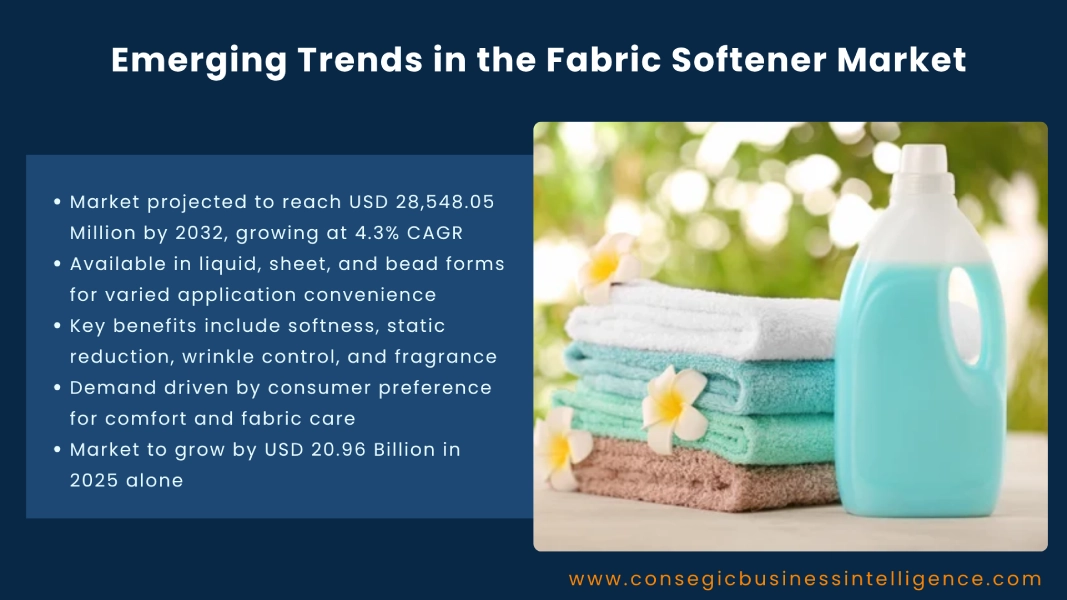Emerging Trends in the Fabric Softener Market
Fabric softener is a laundry additive utilized to make clothes softer, reduces static cling, as well as add a pleasant fragrance. Additionally, fabric softeners come in liquid, sheet, and bead forms, each offering a different method of application and convenience. Also, the key advantages of fabric softeners include reduced friction, reduced static cling, wrinkle reduction and others. According to Consegic Business Intelligence, the fabric softener market size is estimated to reach over USD 28,548.05 Million by 2032 from a value of USD 20,448.32 Million in 2024 and is projected to grow by USD 20,955.06 Million in 2025, growing at a CAGR of 4.30% from 2025 to 2032.

Key Trends Boosting the Fabric Softener Market
- Sustainability and Eco-Friendly Formulations
The increasing demand for sustainable and eco-friendly products is attracting customers towards promoting sustainability and reducing environmental impact of chemical-based products and are actively seeking alternatives. Additionally, the rising adoption of plant-based and natural ingredients made from biodegradable, plant-derived, and non-toxic ingredients are gaining popularity. Moreover, fabric softener manufacturers are introducing products with no parabens, dyes, or harsh chemicals due to stringent rules and regulations for accessing certifications from environmental groups to validate their claims. Further, the availability of alternative to traditional liquid softeners and dryer sheets such as wool dryer balls and fabric softener pods is promoting sustainability and eco-friendliness.
- Product Innovation and Convenience
Manufacturers are innovating fabric softeners to offer a wider range of product forms that cater to modern, busy lifestyles by promoting solutions such as concentrated formulas and refills. Concentrated liquid softeners require less packaging, which makes the product sustainable, eco-friendly as well as attract budget friendly consumers. Additionally, the emergence of fabric softener beads, sprays, and pods is shifting the consumer behavior from traditional liquids and dryer sheets to fabric softeners due to convenient, long-lasting fragrance, static elimination and easy-to-use. Further, the rising consumer demand towards particular fabric softeners designed for specific needs, such as products tailored for soft fabrics such as silk and wool, baby clothes and others.
- Advanced Fragrance Technologies
Fragrance is the most crucial factor in consumer choice while purchasing fabric softener and the market is experiencing significant advancement in the fragrance technologies for fabric softeners. Additionally, customers require pleasant scent that lasts long after the laundry which is achieved through advanced technologies such as micro-encapsulated fragrances that gradually release scent over time. Moreover, the rising demand for particular fragrance is propelling manufacturers to incorporate nature or fine perfumes, moving beyond basic fresh scents. Further, the proliferation of scent boosters in the market designed to provide an extra burst of fragrance alongside regular fabric softeners is boosting the market growth.
- Growth of E-commerce and Digital Marketing
Businesses are increasingly concentrating on building solid online presence, improving D2C models, and increasing investment in strategies for digital marketing, such as influencer marketing. Further, these focuses are aimed towards reaching environmentally aware customers. Additionally, the proliferation of e-commerce is driving the fabric softeners market growth due to advantages including convenience, cost-effectiveness, and wider product availability. Moreover, rising shift in consumer purchasing nature towards online retail is boosting the market growth.
- Increased Consumer Awareness of Fabric Care
The consumers are increasingly focusing on the importance of proper fabric care to extend the life and quality of their clothing by leveraging the knowledge and solutions available on websites. Additionally, consumers are adopting fabric softener with properties such as static cling reduction, wrinkle reduction, color protection, enhanced fabric longevity and others.
- Artificial Intelligence Impact
Artificial intelligence is increasing being integrated to personalize fabric care, by regulating product usage based on fabric type, washing actions, and even skin sensitivity. Additionally, AI algorithms have the ability to evaluate data to create customized fabric softener formulas based on factors such as fabric type, softness, and scent. Also, AI helps in creating eco-friendly fabric softeners by optimizing manufacturing processes and integrating biodegradable and plant-based ingredients. Further, the fabric softener manufacturers leverage the capability of AI to minimalize waste, reduce energy and water consumption, and rationalize the supply chain in the textile industry.
- Health & Wellness
Fabric softeners may contain chemicals such as volatile organic compounds, and synthetic fragrances that can evaporate into the air and irritate the respiratory system of human causing potential health concerns. Additionally, the coating can also trap bacteria and odors, making clothes harder to clean thoroughly which in turn is propelling manufacturers to develop eco-friendly fabric softeners.
Conclusion
The fabric softener market is experiencing significant shifts due to growing consumer demand for eco-friendly products, innovative and convenient formulations, and advanced fragrance technology, among others. Sustainability, e-commerce expansion, rising disposable incomes personalization, and health & wellness are key trends shaping the market.
